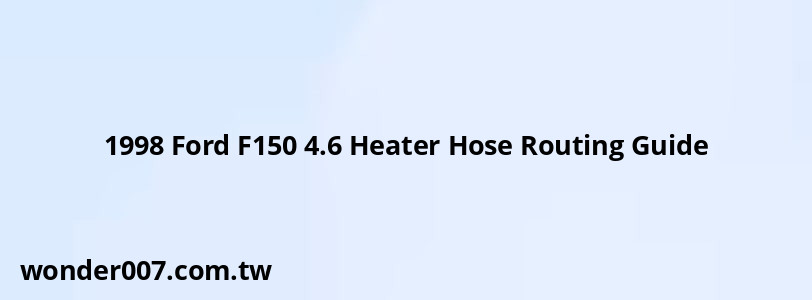1998 Ford F150 4.6 Heater Hose Routing Guide

The 1998 Ford F150 with a 4.6L engine has a specific heater hose configuration that can be tricky to navigate. Understanding the proper routing is crucial for maintaining your vehicle's cooling system and ensuring optimal performance. Let's break down the key components and their layout.
Heater Hose Components
The heater hose system in the 1998 Ford F150 4.6L consists of several main parts:
- Two primary heater hoses
- Quick disconnect fittings
- A metal supply tube
- A 1/4-inch bypass hose
Heater Hose Routing
Supply Hose
The supply hose runs from the engine to the heater core. It's connected to a metal tube at the back of the water pump, located under the intake manifold. This hose carries hot coolant from the engine to the heater core.
Return Hose
The return hose carries cooled fluid back from the heater core to the engine. It typically connects to the intake manifold or water pump, completing the circulation loop.
Bypass Hose
The 1998 model has a 1/4-inch rubber bypass hose. This small hose connects to the metal supply tube near the firewall behind the intake. It then runs to a "tree" on the throttle body elbow and continues to the front of the intake, connecting to the Engine Coolant Temperature (ECT) sensor port.
Quick Disconnect Fittings
The heater hoses use quick disconnect fittings at the firewall connection points. These fittings can be a common source of leaks due to worn O-rings. When replacing, consider using Motorcraft fittings for the best fit and reliability.
Potential Issues
- Leaks: Often occur at the connection behind the passenger side cylinder head
- Brittle Fittings: The plastic quick disconnect fittings can become brittle over time
- Restricted Flow: Buildup in the hoses or fittings can restrict coolant flow
Replacement Tips
- When replacing hoses, ensure you get the correct pre-bent shape for proper fitment
- Consider replacing the O-rings in the quick disconnect fittings if they're still in good condition
- Always use the proper coolant and bleed the system after replacement
Maintenance
Regular inspection of your heater hoses is crucial. Look for:
- Soft or spongy hoses
- Cracks or splits
- Leaks at connection points
- Proper routing without kinks or tight bends
By understanding the layout and potential issues with your 1998 Ford F150 4.6L heater hoses, you can better maintain your vehicle's cooling system and avoid unexpected breakdowns.
Related Posts
-
Clutch Safety Switch Adjustment Guide
29-01-2025 • 179 views -
2004 Ford F150 5.4 Firing Order and Cylinder Layout
26-01-2025 • 154 views -
3800 Series 2: Serpentine Belt Diagram and Replacement Guide
29-01-2025 • 116 views -
Nissan Loose Fuel Cap Reset: Quick Fix Guide
28-01-2025 • 190 views -
Headlight Bulb for 2010 Hyundai Elantra: Complete Guide
29-01-2025 • 216 views
Latest Posts
-
Are O2 Sensors Covered Under Warranty
01-02-2025 • 338 views -
2015 Chevy Traverse AC Recharge Port Location
01-02-2025 • 365 views -
How To Turn Off Paddle Shifters Mercedes
01-02-2025 • 333 views -
Rear Brake Caliper Piston Won't Compress
01-02-2025 • 312 views -
Power Steering Fluid Leak On Passenger Side
01-02-2025 • 419 views
Popular Posts
-
V12 Engine Costs: What You Need to Know
26-01-2025 • 630 views -
EPC Warning Light: What It Means for Your Vehicle
27-01-2025 • 591 views -
Hino Warning Lights: Understanding Dashboard Alerts
26-01-2025 • 634 views -
Power Steering and ABS Light On: Causes and Solutions
27-01-2025 • 612 views -
EPC Light: Understanding Causes and Solutions
26-01-2025 • 1019 views
